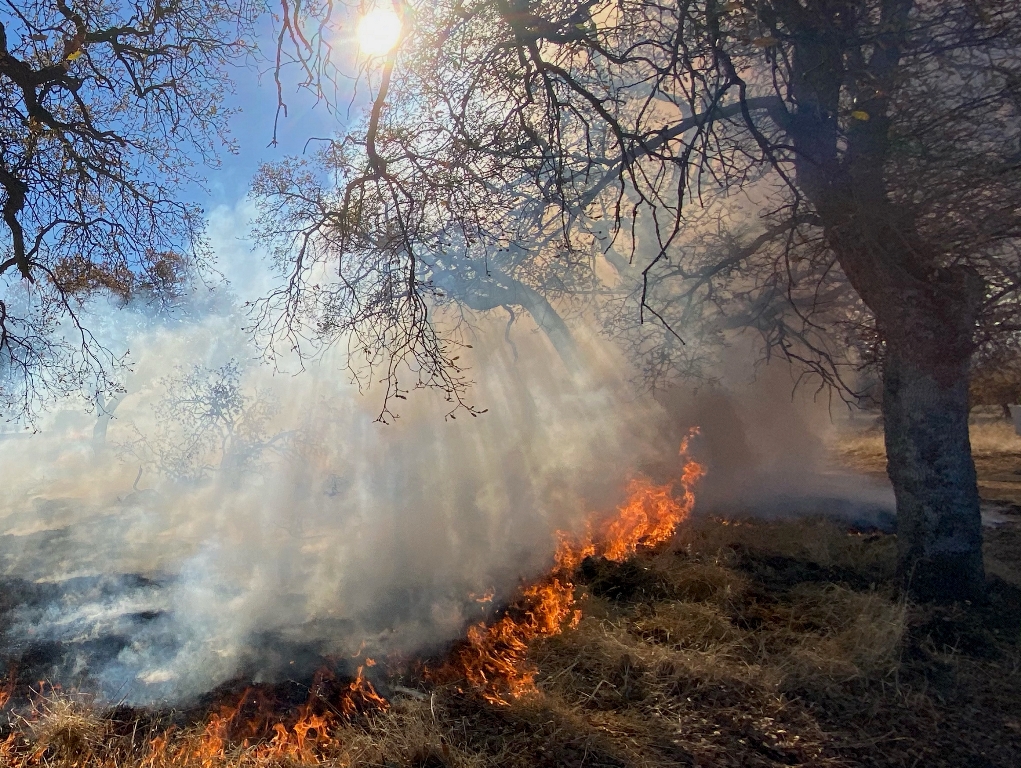You are here
Home » Oak Education and Stewardship Through Cultural Fire: Engaging Indigenous Youth and Building Climate Change Resilience in California Mixed Oak Woodlands

Executive Summary: We propose a collaborative project between the Southern Sierra Miwuk Nation, who are returning cultural fire and other oak stewardship practices to their ancestral oak woodlands in the Sierra Nevada Foothill region, and Dr. Blair McLaughlin, an oak and climate change scientist at the University of California, Santa Cruz. This project relates to the IOS priority conservation themes of 1) Education and 2) Habitat Restoration.
Indigenous people have been living in close relationship with oaks in California for thousands of years, and over this time have developed cultural practices that support oak health, including cultural burning (Anderson 2006; Lake et al. 2017; Kimmerer and Lake 2001). Cultural burning is similar to prescribed burning in its use of intentional, low-severity, carefully managed fires, but also includes the goals of enhancing culturally important plants and animals, such as oaks. In California oak woodlands, cultural burning can be used to reduce pests (Halpern et al. 2022), decrease invasive species (DiTomaso et al. 2006), and reduce the likelihood of catastrophic wildfires (Fernandes and Bothelo 2023) that can lead to oak mortality (reviewed in Abbott et al. in prep).
Because of the removals of Indigenous peoples from their lands, prohibitions on cultural burning, and active fire suppression policies over the last century, many California oak woodlands now suffer from encroachment by conifers, and woody shrubs and invasive species in the understory. This makes them less suitable for cultural activities and increases pests. It also leads to higher understory fuel loads which increase vulnerability to severe wildfires. Wildfire vulnerability is compounded by the increasing temperatures and droughts in the region with climate change, which in essence, make these landscapes more flammable and prone to catastrophic fires (IPCC 2023). To reduce these risks, the state of California, Indigenous Tribes, and conservation NGOs are working toward increasing cultural and prescribed burning in these ecosystems (Miller 2020, Wildfire Task Force 2022). However, raising public awareness about the benefits of cultural burning and training more burn practitioners are key to meeting these conservation goals at the necessary scale (Miller et al. 2020).
In the fall of 2025, we propose to conduct a cultural burn and oak education event at a property recently acquired by the Southern Sierra Miwuk Nation in the Southern Sierra Foothills. We will Educate participants on the reciprocal relationships between Indigenous people and oaks, the benefits of cultural burning, and the threats of climate change to California oak woodlands; Educate and inspire new Indigenous land stewards and cultural burn practitioners; Begin to restore areas of oak woodland habitat; and
Develop video educational materials on restoration of Miwuk stewardship to share broadly.
Through this project, we will begin to restore oak habitat and raise awareness of the importance of and threats to California oak ecosystems; and the ways cultural burning can foster oak woodland health and increase the likelihood of oak survival with climate change.
Target Species:
Quercus lobata (NT)
Quercus douglasii (LC)
Quercus kelloggii (LC)